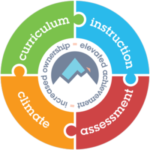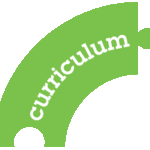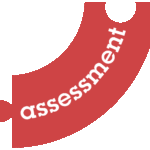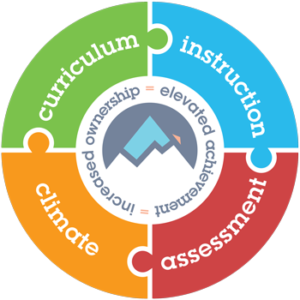Share this article.
Oftentimes at Elevated Achievement, we get requests from teachers from across the nation looking for solutions to specific concerns. Recently, we received a question from a 7th-grade teacher in a large urban middle school regarding implementing a data protocol and reteaching. We felt that her concern was one that would be common with many teachers, so we decided to post the question and the answer here.
Question: My students took a quarterly benchmark exam to see where they were in their effort to master the district standards. I followed my district PLC protocol to analyze my students’ results. I was told to identify the skills that the majority of my students missed and then reteach those. I’ve identified the skills, but I have no idea why my students missed them, so I am unsure of what I need to do to reteach them. Am I missing something?
Answer: Actually, you aren’t missing anything, but your data protocol is. You are correct in feeling that something is missing and that there is more to your job than just identifying what kids didn’t learn and then reteach them. You need to find out exactly why your students didn’t master the standard or skills and then correct that aspect of your teaching.
Let’s restate the Challenge: To implement a data protocol that accurately analyzes student results and ensures appropriate corrective action by the teacher.
Next, for the Solution: When looking at student results it is important to remember that your goal is to identify WHAT students have learned (or not) and WHY they have learned (or not). Without those two pieces clearly identified, you won’t be able to determine HOW to reteach them effectively.
Your data protocol only has you identifying what the students did not learn and then asks you for a reteaching plan. Your data protocol is missing a step: Identify what supports your students received from you, so that you can identify if your students received the best, first instruction.
 So, once you have identified which standard or skill your students have not mastered, you will need to reflect on your instruction of that skill or standard. You will want to analyze what supports your students received from you regarding your curriculum choices, your instructional choices, your assessment choices, and the climate of your classroom. You will reflect on each of these areas to help identify the strengths and gaps of your students’ classroom experience. More than likely, the gaps will help you determine how you will reteach your students—fill in that gap!
So, once you have identified which standard or skill your students have not mastered, you will need to reflect on your instruction of that skill or standard. You will want to analyze what supports your students received from you regarding your curriculum choices, your instructional choices, your assessment choices, and the climate of your classroom. You will reflect on each of these areas to help identify the strengths and gaps of your students’ classroom experience. More than likely, the gaps will help you determine how you will reteach your students—fill in that gap!
Don’t worry, we’ll walk you through the steps.
 1. First, take a look at the curriculum choices and ask: Was all of the student learning driven by the standards with measurable and achievable objectives? Many folks implement (or are told to implement) “standards-based” textbooks or programs and feel they then no longer need to worry about the actual standards. Well, this might not work to the advantage of your students. Hoping students master standards through osmosis isn’t a great game plan. Students need more transparency in their learning.
1. First, take a look at the curriculum choices and ask: Was all of the student learning driven by the standards with measurable and achievable objectives? Many folks implement (or are told to implement) “standards-based” textbooks or programs and feel they then no longer need to worry about the actual standards. Well, this might not work to the advantage of your students. Hoping students master standards through osmosis isn’t a great game plan. Students need more transparency in their learning.
So, think about your teaching and ask:
- Did students know what they were learning (skill or content from the standard) each lesson?
- Did students know how they would show that they had learned the skill or content for each lesson?
- Was the skill integrated into the unit so that students had a variety of opportunities to master that skill or content?
- Did students access materials that matched the rigor and content of what they were learning?
Now, if you think the answer is “no” to any of these questions, you might have discovered one of the reasons why your students didn’t master the standard.
And, more importantly, you have the framework of a plan moving forward:
- Make sure your students know what they are learning during each lesson.
- Make sure your students know how they can show that they learning the skill.
- Make sure the skill is integrated into the unit so that students have a variety of opportunities to master that skill.
- Make sure your students have access to materials that match the rigor and content of what they are learning.
- And make sure your students are able to articulate all of this information.
 2. Second, take a look at the instruction choices and ask: Was all of the student learning driven by research-based, highly effective and efficient instructional practices? Many teachers over-rely (or are told to over-rely) on just one strategy. It could be that this is the only strategy the teacher knows or is comfortable with, but it also could be that this is a district or school initiative that is expected in every lesson. Well, this might not work to the advantage of the student. Research shows that the best instruction practice is the one that is most effective (students learn to the highest degree) and efficient (students learn the quickest) for the stated objective and the needs of the students. Thus, all instructional strategies can be used if they are the most appropriate for the stated objective and the needs of the students.
2. Second, take a look at the instruction choices and ask: Was all of the student learning driven by research-based, highly effective and efficient instructional practices? Many teachers over-rely (or are told to over-rely) on just one strategy. It could be that this is the only strategy the teacher knows or is comfortable with, but it also could be that this is a district or school initiative that is expected in every lesson. Well, this might not work to the advantage of the student. Research shows that the best instruction practice is the one that is most effective (students learn to the highest degree) and efficient (students learn the quickest) for the stated objective and the needs of the students. Thus, all instructional strategies can be used if they are the most appropriate for the stated objective and the needs of the students.
So, think about your teaching and ask:
- Did students have opportunities to make meaning with each other?
- Did students have opportunities to engage in a variety of instructional strategies?
- Did students receive sufficient time to master the learning?
Now, if you think the answer is “no” to any of these questions, you might have discovered one of the reasons why your students didn’t master the standard.
And, more importantly, you have the framework of a plan moving forward:
- Make sure your students have opportunities to make meaning with each other.
- Make sure your students have opportunities to engage in a variety of instructional strategies.
- Make sure your students have sufficient time to master the learning.
- And make sure your students are able to articulate all of this information.
 3. Third, take a look at the in-classroom assessment choices and ask: Was all of the student learning drive by regular assessment which determined instructional modifications? Many teachers wait until the end of a lesson or unit to assess if students have mastered the skill or content. Waiting until the end might not work to the advantage of your students. Knowledge of your students’ current understanding lets you adjust and refocus at a moment’s notice. This quick refocusing is easier to do if you have a clear objective and almost impossible to do if you don’t.
3. Third, take a look at the in-classroom assessment choices and ask: Was all of the student learning drive by regular assessment which determined instructional modifications? Many teachers wait until the end of a lesson or unit to assess if students have mastered the skill or content. Waiting until the end might not work to the advantage of your students. Knowledge of your students’ current understanding lets you adjust and refocus at a moment’s notice. This quick refocusing is easier to do if you have a clear objective and almost impossible to do if you don’t.
So, think about your teaching and ask:
- Did students have opportunities to explain when they were learning and when they were struggling?
- Did students receive supportive feedback regarding their struggles?
- Was instruction adjusted based on what the students were learning or were struggling with?
- Was instruction differentiated based on identified student needs such as having an IEP or being an English learner?
Now, if you think the answer is “no” to any of these questions, you might have discovered one of the reasons why your students didn’t master the standard.
And, more importantly, you have the framework of a plan moving forward:
- Make sure your students have opportunities to explain when they are learning and when they are struggling.
- Make sure your students receive supportive feedback regarding their struggles.
- Make sure you adjust instruction based on what your students are learning or struggling with.
- Make sure you differentiate instruction based on identified student needs such as having an IEP or being an English learner.
- And make sure your students are able to articulate all of this information.
 4. Last, take a look at the classroom climate and ask: Was all of the student learning driven by a positive climate? Many teachers feel that a well-managed room (many times meaning quiet and calm) is a positive climate. However, this might not work to the advantage of your students. A well-managed room does not necessarily translate to a positive academic learning environment. A positive academic learning environment is one where students feel respected and safe, are encouraged to ask questions and take risks, and are clear about their role in the learning. Learning is hard—and making mistakes is integral to academic growth. So, how well the teacher supports students in growing, taking risks, and responsibility for their role is crucial.
4. Last, take a look at the classroom climate and ask: Was all of the student learning driven by a positive climate? Many teachers feel that a well-managed room (many times meaning quiet and calm) is a positive climate. However, this might not work to the advantage of your students. A well-managed room does not necessarily translate to a positive academic learning environment. A positive academic learning environment is one where students feel respected and safe, are encouraged to ask questions and take risks, and are clear about their role in the learning. Learning is hard—and making mistakes is integral to academic growth. So, how well the teacher supports students in growing, taking risks, and responsibility for their role is crucial.
So, think about your teaching and ask:
- Was the classroom a respectful environment that honored and promoted each and every student?
- Did the classroom environment encourage risk-taking?
- Did the classroom environment encourage cooperation and collaboration?
- Did the students recognize that by supporting each other they actually get smarter?
- Were the students clear about their role in the learning?
Now, if you think the answer is “no” to any of these questions, you might have discovered one of the reasons why your students didn’t master the standard.
And, more importantly, you have the framework of a plan moving forward:
- Make sure your students are in a respectful environment that honors and promotes each and every student.
- Make sure your students are in an environment that encourages risk-taking.
- Make sure your students are in an environment that encourages cooperation and collaboration.
- Make sure that students recognize that supporting each other helps them actually get smarter.
- Make sure that students are clear about and can take responsibility for their role in the learning.
- And mark sure that your students are able to articulate all of this information.
In other words, reteaching cannot be effective and efficient if the teacher does not clearly understand what worked (and didn’t) during classroom instruction. Reflecting on your practice will help you reteach better, initially teach better, and share teaching strategies with your colleagues.
Continue the Learning
Check out these articles and resources to continue your learning about this topic…
The Learning Brief
In this article you learned…
- Reteaching cannot be effective and efficient if the teacher does not clearly understand what worked (and didn’t) during classroom instruction.
- There should be more to data protocols than just identifying what kids didn’t learn and then reteach them.
- To identify WHAT students have learned (or not) and WHY they have learned (or not, in order to determine HOW to reteach them effectively.
Can you imagine building an environment full of motivated, engaged, and eager students who own their learning?
We can.


